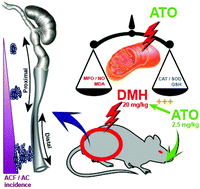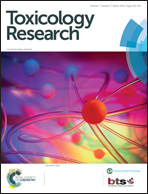Arsenic trioxide exposure accelerates colon preneoplasic aberrant crypt foci induction regionally through mitochondrial dysfunction
Abstract
Arsenic poisoning is a worldwide problem. Thus, we studied the effects of arsenic trioxide (ATO) administration on a 1,2-dimethylhydrazine (DMH)-induced preneoplasic colon carcinogenesis model. Mice were separated into four study groups; the control group received only vehicles. The ATO group received daily a 2.5 mg kg−1 dose for 4 weeks. The DMH group received DMH (20 mg kg−1) twice in two weeks. The third group (D-ATO) had the same as the DMH group with ATO administration starting at week 10. At the end of 14 weeks, colons from sacrificed mice were taken, segmented into distal and proximal and subjected to aberrant crypt foci (ACF), aberrant crypt (AC) counting, alcian blue, H&E and Hoechst histological study and lastly oxidative stress marker analysis as well as mitochondrial swelling assessment. Data showed a significant increase in ACF and AC after DMH treatment, which was further increased after ATO addition. A perturbed histological structure was observed and loss of mucin producing cells in the colon tissue was observed. An important impact on the distal colon compared to the proximal one was noticed. The oxidative stress balance showed a similar pattern with an increase in MPO, NO/L-ornithine balance and MDA, while a decrease was observed in the antioxidant enzymes (CAT, SOD and GSH). In all parameters analyzed, the distal colons showed higher values than proximal. Furthermore, histological cell death analysis in combination with mitochondrial permeability pore opening suggested ATO contribution in the pathological effect. Our study has shown that ATO administration accelerated colon cancer development suggesting the heaviness of such treatments and the need to explore combinations and cycle type formulas.



 Please wait while we load your content...
Please wait while we load your content...